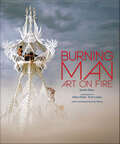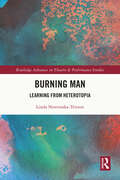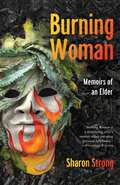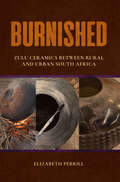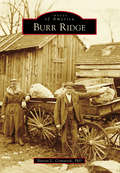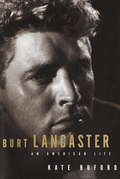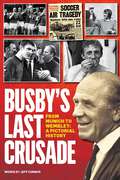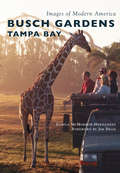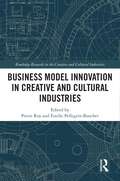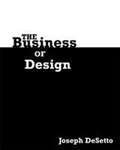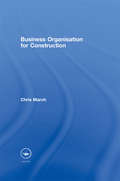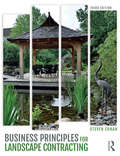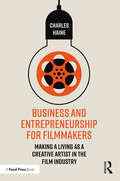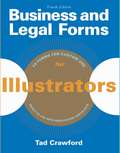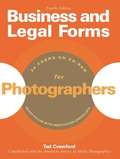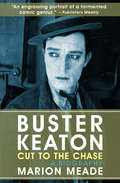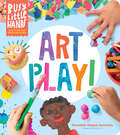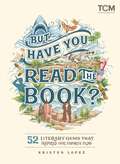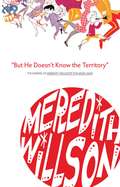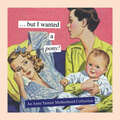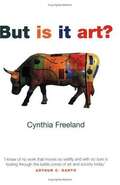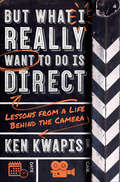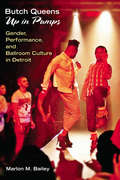- Table View
- List View
Burning Man: Art on Fire
by Jennifer RaiserEvery August, tens of thousands of participants gather to celebrate artistic expression in Nevada's barren Black Rock Desert. This vastly inhospitable location, called the playa, is the site of Burning Man, where, within a 9-mile fence, artists called Burners create a temporary city devoted to art and participation. Braving extreme elements, over two hundred wildly ambitious works of art are created and intended to delight, provoke, involve, or amaze. In 2013, over 68,000 people attended - the highest number ever allowed on the playa. As Burning Man has created new context, new categories of art have emerged since its inception, including Art to Ride, Collaborative Art, and of course, Art to Burn. Burning Man: Art on Fire is an authorized collection of some of the most stunning examples of Burning Man art. Experience the amazing sculptures, art, stories, and interviews from the world's greatest gathering of artists. Get lost in a rich gallery of images showcasing the best examples of playa art with 170 photos. Interviews with the artists reveal not only their motivation to create art specifically for Burning Man, but they also illuminate the dramatic efforts it took to create their pieces. Featuring the incredible photography of long-time Burning Man photographers, Sidney Erthal and Scott London, an introduction from Burning Man founder Larry Harvey, and a foreword from Will Chase, this stunning gift book allows Burners and enthusiasts alike to have a piece of Burning Man with them all year around.
Burning Man: Learning from Heterotopia (Routledge Advances in Theatre & Performance Studies)
by Linda Noveroske-TrittenThis book centres on a philosophical analysis of creative acts in the Burning Man Festival and their roles in wider social change. With particular focus on the Ten Principles of Burning Man, Linda Noveroske posits a re-interpretation of common notions of “self” and “other” as they apply to identity, difference, and the ways that these personal impulses ripple outward from changing individuals into changing societies. Such radical re-imagination of ideology can be most powerful when it occurs in spaces of otherness, of heterotopia. This study casts Burning Man as a heterotopia to not only destabilizes what we think we know about visual art, performance, and creative encounters, but also bring these acts into an attitude of immediacy that facilitates previously unimagined behaviour and opens out artistic drive into the unknown. This book would be of value for scholars and practitioners in Performance Studies, Theatre and Dance, Art History, Psychology, Phenomenology, Architecture and Urban Studies.
Burning Woman: Memoirs of an Elder
by Sharon StrongAt sixty-five, artist, writer, and psychologist Sharon Strong doesn&’t fit into the cultural stereotype of &“senior citizen&”—and she has no desire to. Instead, she claims the next decade as the most transformational years of her life. At sixty-six, she erects the first of what will become a series of monumental sculptures on the Black Rock Desert at Burning Man. At sixty-seven, she treks in the Himalayas. At seventy, she meets the love of her life and begins a new life with him. To honor her seventy-fifth year, she delves into an inward journey with psilocybin mushrooms.But life has its own seasons and time. The Great Recession necessitates the closing of Sharon&’s gallery. She comes to the end of Burning Man. A wildfire destroys her home and, most devastating of all, completely incinerates her art studio and twenty years&’ worth of work.Through it all, Sharon honors her experiences—even the most painful ones—because she knows that each one helps shape who she is. Ultimately, Burning Woman is a passionate love story about the adventure of aging that will inspire readers to feel their strength and commit to living their lives to the fullest and with a sense of pride and purpose.
Burnished: Zulu Ceramics between Rural and Urban South Africa
by Elizabeth PerrillWhen Zulu women potters innovate or move to a more urban setting, they are asked why they have abandoned tradition. Yet when they continue to follow convention or choose to stay in rural areas, art historians speak of their work as unchanging symbols of the past. Burnished rejects both stereotypes, acknowledging the agency of rural women as innovative artists and complex individuals negotiating a biased set of power structures.Featuring 90 color images, Burnished engages directly with individual artists and specific vessels, fracturing assumptions that Zulu ceramicists are resistant to rural transformation and insulated from urban realities. Elizabeth Perrill shares compelling narratives of women ceramic artists and the sophisticated beer pots they create—their aesthetic choices, audiences, production, and artistic lives. Simultaneously, Perrill documents the manner in which and reasons why ceramic arts, and at times the artists themselves, capitalize upon bucolic stereotypes of rural womanhood, are constrained by artistic methods, or chafe against definitions of what qualifies as a Zulu pot.Revealing how white South Africans and global art gatekeepers have continually twisted the designation of Zulu ceramics before, during, and after apartheid, Burnished provides an engaging look at the artistry of entrepreneurial Black women too often erased from historical records.
Burr Ridge (Images of America)
by Sharon L. ComstockThe Village of Burr Ridge is aptly named--and not merely for the bur oaks, nor the limestone ridges as the land nears Flagg Creek. Before there was Burr Ridge, frontier German, English, French, Scottish, and Native Americans came to these forests. The Plainfield and Joliet trails were early Native American and frontier routes to and from trading posts, and oral histories recount the Potawatomi stopping near what would become County Line Road. The angled routes of Plainfield Road and Historic Route 66 are silent reminders of these past trails and travelers. In 1917, International Harvester Company opened a research facility along County Line and Plainfield Roads to perfect agricultural equipment, namely the iconic Farmall tractor. This inspired the namesake village, Harvester, in 1956, which was renamed Burr Ridge in 1962. The modern Illinois Interstates 55 and 294 intersect near Burr Ridge, spurring growth. Today, the village has the distinction of being one of the wealthiest communities in the United States.
Burt Lancaster
by Kate BufordStartlingly handsome, witty, fanatically loyal, charming, scary, and intensely sexual, Burt Lancaster was the quintessential bête du cinéma, one of Hollywood's great stars. He was, as well, an intensely private man, and he authorized no biographies in his lifetime. Kate Buford is the first writer to win the cooperation of Lancaster's widow, close friends, and colleagues, and her book is a revelation. Here is Lancaster the man, from his teenage years, bolting the Depression-era immigrant neighborhood of East Harlem where he grew up for the life of a circus acrobat -- then the electric New York theater of the 1930s, then the dying days of vaudeville. We see his production company -- Hecht-Hill-Lancaster -- become the biggest independent of the 1950s, a bridge between the studio era and modern filmmaking. With the power he derived from it we see him gain a remarkable degree of control, which he used to become the auteur of his own career. His navigation through the anti-Communist witch-hunts made him an example of a star who tweaked the noses of HUAC and survived. His greatest roles -- in Sweet Smell of Success, Elmer Gantry, Birdman of Alcatraz, The Swimmer, Atlantic City -- kept to the progressive edge that had originated in the tolerant, diverse, reforming principles of his childhood. And in the extraordinary complete roster of his films -- From Here to Eternity, Gunfight at the O.K. Corral, Judgment at Nuremberg, The Leopard, 1900, and Field of Dreams, among many others -- he proved to be both a master of commercial movies that pleased a worldwide audience and an actor who pushed himself beyond stardom into cinematic art. Kate Buford has written a dynamic biography of a passionate and committed star, the first full-scale study of one of the last great unexamined Hollywood lives.
Busby's Last Crusade: From Munich to Wembley: A Pictorial History
by Jeff ConnorA pictorial history of Manchester United’s rise from the 1958 Munich air disaster to a European Cup win ten years later, and the manager who led them there.With words from best-selling author Jeff Connor and over 200 images, many of them new to the public, this is one man’s search for his personal Holy Grail, and his determination to get there. This is not a eulogy for Sir Matt Busby. As Connor points out, his roles as a club director after 1968 will always be questioned and that King Arthur would never have succeeded without his knights: Duncan Edwards, Roger Byrne, Bobby Charlton, George Best, Denis Law and, above all, Jimmy Murphy. All of these, and others, lighten the pages of a book certain to be seen by fans everywhere as a permanent memoir of an unforgettable era.
Busch Gardens Tampa Bay (Images of Modern America)
by Joshua Mcmorrow-Hernandez Foreword By DeanWhen Busch Gardens Tampa Bay opened in 1959, the Tampa, Florida, park became an immediate hit with locals and tourists alike. Over the decades, Busch Gardens has grown to become an internationally acclaimed and accredited zoological facility and world-renowned theme park. Serving as a sanctuary for thousands of exotic and endangered animals from around the globe and offering up unique thrilling rides and world-class entertainment, Busch Gardens Tampa Bay proudly welcomes millions of guests each year.
Business Model Innovation in Creative and Cultural Industries (Routledge Research in the Creative and Cultural Industries)
by Pierre Roy Estelle Pellegrin-BoucherBusiness model innovation occurs when an organization discovers a new way of creating revenues or profits via its products or services. This book examines the concept as it applies across the creative and cultural industries in practice.This book examines market, social and political environments which impact creative and cultural organizations' business models, such as sustainability, new forms of competition, digitalization and data management, emerging technologies like AI, and shifting social trends and lifestyles. This book not only analyses these influences but also presents best practices, key success factors, and compelling case studies. Employing a case study format, a range of creative or cultural sectors are analysed, including fashion, architecture and gaming.The result is a book which delivers value for researchers, advanced students, and reflective practitioners involved in the creative economy around the world.
Business Of Design
by Joseph DeSettoIn a business climate that views creative work as one of the last sustainable competitive advantages, design students need to understand what awaits them once classes are over. The Business of Design enables designers and other creative professionals to successfully apply their talents in the marketplace by teaching the basics of marketing, proposals, legal considerations and working with clients. If you're looking for a tool to help your students' bridge the gap between their creative knowledge and the essential business acumen required to be successful, then The Business of Design is a must for your classroom.
Business Organisation for Construction
by Chris MarchWith a user-friendly style and a strong theoretical base, Business Organisation for Construction provides readers with the tools required to skillfully and successfully operate a business in today's construction industry. Arranged into three sections, Chris March explains: strategy and vision, business finance and the market place the organization, recruitment, support, motivation and leadership of people communication and negotiation. With a wealth of practical construction industry experience, March provides rich anecdotal evidence to enlighten the theory, as well as illustrations and tables to clarify. Available singly or as part of a set, Business Organisation for Construction is a valuable resource for construction students.
Business Principles for Landscape Contracting
by Steven CohanBusiness Principles for Landscape Contracting, fully revised and updated in its third edition, is an introduction to the application of business principles of financial management involved in setting up your own landscape contracting business and beginning your professional career. Appealing to students and professionals alike, it will build your knowledge of financial management tools and enable you to relate their applications to real-life business scenarios. Focusing on the importance of proactive financial management, the book serves as a primer for students in landscape architecture, contracting, and management courses and entrepreneurs within the landscape industry preparing to use business principles in practice. Topics covered include: Financial management and accountability Budget development Profitable pricing and estimating Project management Creating a lean culture Personnel management and employee productivity Professional development Economic sustainability.
Business and Entrepreneurship for Filmmakers: Making a Living as a Creative Artist in the Film Industry
by Charles HaineThis practical guide teaches readers the skills and business acumen required to build a career in the film industry from the ground up. While countless books and classes teach newcomers the creative aspects of the film industry, many fail to properly prepare readers for the reality of how to navigate a freelance film career today. From creating a business model, dealing with taxes and funding, finding and managing clients, networking, investing, cashflow, and planning for the long-term, Business and Entrepreneurship for Filmmakers provides real-world, pragmatic advice on navigating a freelance film career, whether you’re a recent film school graduate looking to take the next step or a seasoned professional hoping to start a production company. Moreover, the skills taught here apply across the industry, from corporate media and commercials to music videos and feature films. Interviews with filmmakers, innovators, and business experts are included throughout the book to offer further expertise and examples.
Business and Legal Forms for Illustrators (Business And Legal Forms Ser.)
by Tad CrawfordThe fourth edition of this popular guide contains twenty-nine of the most essential business and legal forms to meet the everyday needs of today’s illustrators. Updated throughout, new forms include a promissory note, releases, and an agreement to arbitrate. Each form is accompanied by step-by-step instructions, advice on standard contractual provisions, and unique negotiation checklists for making the best deal. Included are:Estimate Confirmation of Assignment Invoice Illustrator-Agent Contract Book Publishing Contract Collaboration Contract Contract for the Sale of an Artwork Contract for Receipt and Holding of Artwork Illustrator-Gallery Contract with Record of Consignment and Statement of Account Licensing Contract to Merchandise Images Release Form for Models Property Release Permission Form Nondisclosure Agreement for Submitting Ideas Copyright Transfer Form Application for Copyright Registration of Artwork License of Rights and Electronic Rights Contract with an Independent Contractor Trademark Application Commercial Lease Sublease Lease AssignmentThe collection provides a password and link to a supplemental website, which contains all the discussed forms for both the PC and Mac platforms. Thorough discussions of legal issues relevant to the industry make this a must-read for any illustrator-established or starting out.Allworth Press, an imprint of Skyhorse Publishing, publishes a broad range of books on the visual and performing arts, with emphasis on the business of art. Our titles cover subjects such as graphic design, theater, branding, fine art, photography, interior design, writing, acting, film, how to start careers, business and legal forms, business practices, and more. While we don't aspire to publish a New York Times bestseller or a national bestseller, we are deeply committed to quality books that help creative professionals succeed and thrive. We often publish in areas overlooked by other publishers and welcome the author whose expertise can help our audience of readers.
Business and Legal Forms for Photographers (4th Edition)
by Tad CrawfordIncluded are contracts for wedding, portrait, and assignment photography; publishing, collaboration, and licensing contracts; property and model releases; assignment estimate/confirmation/invoice; delivery memo; stock photography invoice; stock agency agreement; permission form; copyright registration and transfer forms; nondisclosure agreement; license of rights; license of electronic rights; trademark application; employment application and agreement; and more. Included is a CD-ROM containing electronic versions of each form. New to this edition are forms for leases, subleases, and lease assignments, plus an update to cover changes in copyright registration.
Buster Keaton: A Biography
by Marion MeadeAn American icon, Joseph Frank &“Buster&” Keaton is easily acknowledged as one of the greatest filmmakers in early cinema and beyond. His elaborate slapstick made audiences scream with laughter. But, his stone face hid an internal turmoil. In BUSTER KEATON: CUT TO THE CHASE, biographer Marion Meade seamlessly lays out the life and works of this comedy genius who lacked any formal education.&“Buster&” made his name as a child of vaudeville, thrown around the stage by his father in a cartoon pantomime of very real abuse. The lessons he carried forward from that experience translated into some of the greatest silent films of all time. Keaton wrote, directed, performed, and edited dozens of features and shorts, including his masterpiece, The General. However, those early scars also led to decades of drinking and mistreatment of women. Keaton saw huge successes, Hollywood sex scandals, years of neglect from studios and audiences, and finally a shaky resurrection that assured his place in Hollywood&’s film canon.Meticulously researched, this book brings together four years of research and hundreds of interviews to paint a nuanced portrait of a compelling artist. No comedy fan or film buff should miss this insider story of the man behind the stone face.
Busy Bags Kids Will Love: Make-Ahead Activity Kits for a Happy Preschooler and Stress-Free Parent
by Sara McClureAn engaging variety of mentally stimulating activities that keep children away from the TVAs the parent of young children, it's hard to find a moment for yourself. Busy Bags Kids Will Love offers you a smart way to keep your kids engaged so you can relax. With step-by-step instructions and color photos on each page, it will teach you how to make fun, unique games with simple arts-and-crafts materials you have at home.Packed full of enough ideas for every week of the year, this book provides your kids with entertaining, exciting and educational activities, including:• Fishing for colorful letters and numbers• Building shapes with pipe cleaners and straws• Practicing words by rolling the dice• Getting creative with funny felt faces• Exploring textures with blocks, nuts, bolts and zippers• Learning to count with pom-pom patterns
Busy Little Hands: Activities for Preschoolers (Busy Little Hands)
by Meredith Magee DonnellyThis visual activity book specially designed for preschoolers sparks creativity and fosters hands-on learning through easy, open-ended art projects that use paint, papers, clay, and other common art supplies.
But Have You Read the Book?: 52 Literary Gems That Inspired Our Favorite Films (Turner Classic Movies)
by Kristen LopezFor film buffs and literature lovers alike, Turner Classic Movies presents an essential guide to 52 cinema classics and the literary works that served as their inspiration. &“I love that movie!&” &“But have you read the book?&” Within these pages, Turner Classic Movies offers an endlessly fascinating look at 52 beloved screen adaptations and the great reads that inspired them. Some films, like Clueless—Amy Heckerling&’s interpretation of Jane Austen&’s Emma—diverge wildly from the original source material, while others, like One Flew Over the Cuckoo's Nest, shift the point of view to craft a different experience within the same story. Author Kristen Lopez explores just what makes these works classics of both the page and screen, and why each made for an exceptional adaptation—whether faithful to the book or exemplifying cinematic creative license. Other featured works include:Children of Men · The Color Purple · Crazy Rich Asians · Dr. No · Dune · Gentlemen Prefer Blondes · Kiss Me Deadly · The Last Picture Show · Little Women · Passing · The Princess Bride · The Shining · The Thin Man · True Grit · Valley of the Dolls · The Virgin Suicides · Wuthering Heights
But He Doesn't Know the Territory
by Meredith WillsonComposer Meredith Willson once described The Music Man as &“an Iowan&’s attempt to pay tribute to his home state.&” Never once forgetting his roots, Willson reflects on the ups and downs, surprises and disappointments, and finally successes of the making of one of America&’s most popular musicals. His whimsical, personable writing style will bring readers back in time with him to the 1950s to experience firsthand the exciting trials and tribulations of creating a Broadway masterpiece. A newfound admiration for The Music Man—and the man behind the music—is sure to follow.
But I Wanted a Pony!: An Anne Taintor Motherhood Collection
by Anne TaintorThis collection of vintage-with-a-twist artwork offers a fresh serving of hilarious commentary on the joys, challenges, and cocktail hours of motherhood. From the fundamentals (WOW! I get to give birth AND change diapers!) to putting food on the table (you see them as pies . . . I see them as cries for help) to dealing with childhood questions (because I&’m the mother . . . that&’s why) and strategies for taking the edge off (now be a dear and fetch mommy her flask), Taintor expertly captures the funny, frantic, and honest thoughts that most moms have experienced, with an attitude mothers everywhere will welcome.
But Is It Art?: An Introduction to Art Theory
by Cynthia FreelandIn today's art world many strange, even shocking, things qualify as art. <p><p> In this book, the author explains why innovation and controversy are valued in the arts, weaving together philosophy and art theory with many fascinating examples. She discusses blood, beauty, culture, money, museums, sex, and politics, clarifying contemporary and historical accounts of the nature, function, and interpretation of the arts. Freeland also propels us into the future by surveying cutting-edge web sites, along with the latest research on the brain's role in perceiving art. <p><p> This clear, provocative book engages with the big debates surrounding our responses to art and is an invaluable introduction to anyone interested in thinking about art.
But What I Really Want to Do Is Direct: Lessons from a Life Behind the Camera
by Ken KwapisFor over three decades, director Ken Kwapis has charted a career full of exceptional movies and television, from seminal shows like The Office to beloved films like He’s Just Not That Into You.He is among the most respected directors in show business, but getting there wasn’t easy. He struggled just like everyone else. With each triumph came the occasional faceplant. Using his background and inside knowledge, But What I Really Want To Do is Direct tackles Hollywood myths through Ken’s highly entertaining experiences. It’s a rollercoaster ride fueled by brawls with the top brass, clashes over budgets, and the passion that makes it all worthwhile.This humorous and refreshingly personal memoir is filled with inspiring instruction, behind-the-scenes hilarity, and unabashed joy. It’s a celebration of the director’s craft, and what it takes to succeed in show business on your own terms. "Ken Kwapis always brought out the best in the actors on The Office. Whenever Ken was directing, I always felt safe to go out on a limb and take chances, knowing he had my back. Every aspiring director should read this book. (I can think of several 'professional' directors that should read it too!)" -Jenna Fischer"A vital, magnificent manifesto on the art and craft of directing, written with emotional, instinctual and intellectual depth by one of America's most beloved film and television directors" -Amber Tamblyn"In the years that I was fortunate to work with Ken on Malcolm in the Middle, he had an uncanny ability to guide actors right to the heart of a scene and reveal its truths. He admits that he doesn’t have all the answers, he’ll make mistakes, and at times he’ll struggle, but as he says in the book, 'It’s the struggle to get it right that makes us human.'" -Bryan Cranston"Good luck finding a more kind, passionate, and talented director alive than Ken. Seriously, good luck." -Tig Notaro“'Action!' is what most directors bark out to begin a scene. But Ken Kwapis starts by gently intoning the words 'Go ahead…' That simple suggestion assures everyone they’re in smart, capable, humble hands. That’s how you’ll feel reading this book. And so, if you’re anxious to discover how a top director always brings humor, honesty, and humanity to his work, all I can tell you is…Go ahead." -Larry Wilmore
But You Like Really Dated?!: The Celebropedia of Hollywood Hookups
by Ryan CaseyEvery time a celebrity couple breaks up, an angel gets its wings...Admit it—but you're like really a pop-culture junkie, aren't you? And a junkie needs a fix. Am I right? Of course I am. Well, my friends, But You Like Really Dated?! is the perfect remedy. With more dirt than you can find under Lindsay Lohan's fingernails, and enough gossip to make even Joan Rivers blush, this exquisitely designed, epic tome is the ultimate guide to the stars who dated, dumped, hooked up, cheated on, married, divorced, married again, or made a sex tape in the wild world of Hollywood. If you have ever wondered just how many blonde models Leo has shown the town, or how many boy-toys have graced Britney's arm, But You Like Really Dated?! is the only book you'll ever need.Full of hilarious (and hilariously accurate) illustrations of the most notorious members of Hollywood's elite and brimming with sharp commentary about the strange mating habits of celebrities, But You Like Really Dated?! is the brainchild of Ryan Casey, creator of the award-winning webcomic ButYoureLikeReallyPretty.com.So put up your feet, pop open a bottle of your favorite spirits, and dive into the wild and wacky world of the celebrity dating game.
Butch Queens Up in Pumps: Gender, Performance, and Ballroom Culture in Detroit
by Marlon M. BaileyButch Queens Up in Pumpsexamines Ballroom culture, in which inner-city LGBT individuals dress, dance, and vogue to compete for prizes and trophies. Participants are affiliated with a house, an alternative family structure typically named after haute couture designers and providing support to this diverse community. Marlon M. Bailey's rich first-person performance ethnography of the Ballroom scene in Detroit examines Ballroom as a queer cultural formation that upsets dominant notions of gender, sexuality, kinship, and community.
